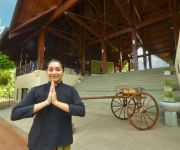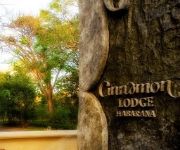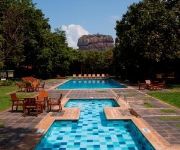Facts and Data
Webpages:
Official Unesco Page
View photos from OUR PLACE the World Heritage collection
Basis Data:
Unesco World heritage since: 1982
Size of heritage:
Coordinates:
Longitude: 80,750°
Latitude: 7,950°
Summary
The ruins of the capital built by the parricidal King Kassapa I (477–95) lie on the steep slopes and at the summit of a granite peak standing some 180m high (the 'Lion's Rock', which dominates the jungle from all sides). A series of galleries and staircases emerging from the mouth of a gigantic lion constructed of bricks and plaster provide access to the site.
Location on Map
Show bigger map on Openstreetmap
Introduction
The Ancient City of Sigiriya is a UNESCO World Heritage site located in the Central Province of Sri Lanka, specifically in the Matale District. This historical site is renowned for its impressive rock fortress, which stands atop a massive column of rock that dominates the surrounding landscape. The site is not only a testament to the architectural brilliance of ancient Sri Lankan civilization but also holds great historical and cultural significance.
History
The history of the Ancient City of Sigiriya dates back to the 5th century AD when it served as a royal palace and fortress. It was built by King Kasyapa I, who sought refuge on the rock after usurping the throne from his father. The king transformed the rock into a fortified city, complete with gardens, reservoirs, and intricate water systems.
After the death of King Kasyapa I, Sigiriya was abandoned and used as a Buddhist monastery until the 14th century. The site was then largely forgotten until it was rediscovered by British archaeologist John Still in 1898. Since then, extensive restoration and conservation efforts have been undertaken to preserve this remarkable historical site.
Current State
Today, the Ancient City of Sigiriya stands as a testament to the ingenuity and architectural prowess of ancient Sri Lankan civilization. The most prominent feature of the site is the rock fortress, which rises 200 meters above the surrounding plains. Visitors can climb to the top of the rock via a series of staircases and pathways, offering breathtaking views of the surrounding landscape.
At the summit of the rock, the remains of the ancient palace can still be seen, including the foundation walls, the royal bathing pool, and the famous frescoes known as the "Sigiriya Damsels." These frescoes depict beautiful maidens and are considered one of the finest examples of ancient Sri Lankan art.
Aside from the rock fortress, the Ancient City of Sigiriya also boasts well-preserved gardens and water features. The water gardens, known as the "Sigiriya Gardens," are a marvel of ancient engineering, with intricate irrigation systems and fountains. The gardens are adorned with various terraces, ponds, and pavilions, creating a serene and picturesque atmosphere.
Due to its historical and cultural significance, the Ancient City of Sigiriya was designated as a UNESCO World Heritage site in 1982. The site attracts thousands of visitors each year, who come to marvel at its architectural wonders and immerse themselves in its rich history.
Conclusion
The Ancient City of Sigiriya in Sri Lanka is a remarkable UNESCO World Heritage site that showcases the architectural brilliance and historical significance of ancient Sri Lankan civilization. From the awe-inspiring rock fortress to the meticulously designed gardens and water features, Sigiriya offers a glimpse into the past and provides a unique cultural experience for visitors. Its designation as a World Heritage site ensures its preservation for future generations to appreciate and learn from.
Hotels and places to stay
Signature by Amaya Luxury Resort
Wild Grass Nature Resort
Seerock The King's Domain
The Paradise Resort & Spa
Cinnamon Lodge Habarana
Hotel Wewa Addara
Vista Wewa Addara
HOTEL SIGIRIYA
Kuwera Eco Lodge
Nice Place Bungalows
Videos from the area
Videos provided by Youtube are under the copyright of their owners.

















